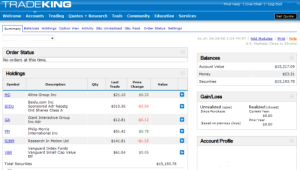Hello everyone! Welcome to the final installment of Bevo Markets and Bear Markets. This week will end our conversation by looking into a favorite tool of many excellent traders: investment research companies. Traditionally, banks, fund managers and elite traders were the only professionals with access and power to tremendous market and company research.
This changed dramatically with the rise of the internet, as it no longer cost hundreds of dollars to get one piece of advice from an overpaid banker across the country. No, the tables have turned. Companies such as Morningstar Inc. thrive on providing incredibly accurate, analytically sound research and recommendations to average traders, often for a fraction of the cost.
Specifically focusing on one of the most well known of these companies, Morningstar Inc., the blog will look at what makes these services so valuable and how they are used by everyday traders. Additionally, the focus will be on the company’s security options and how this research can educate and improve the skills of new investors. Investment research companies such as Morningstar Inc. can dramatically help those who are looking for a way to kick-start their journey to investing artfully.
An example of Morningstar Inc.’s fund comparison tool.
http://www.tradeeagle.com/Portals/1/Images/morningstar/Morningstar2.png)
The most valuable facet of investment research companies like Morningstar Inc. is the sheer volume of stocks, bonds, funds, ETF’s, and markets covered by the service. For each of these covered securities, highly skilled analysts make their recommendations to subscribers on whether to buy, hold or sell them. Traders, along with their own research, consider these recommendations and make trades because of their decisions about the company.
According to the company’s website, Morningstar covers thousands of securities, a huge array of information to subscribers. Non-subscribers can benefit from the company’s expertise, however, via many free resources offered by the company. An example of this can be seen in a free YouTube video showing analysts covering the International ETF market.
If young traders want to improve their ability to value a company, there is no better place to start than with a service like this. When a novice trader sees a high rating for a security, he or she can study what components that company has in common with other highly regarded companies. This comparison starts building a mental tool kit with which the investor can start to assess securities on his or her own.
While a number of other, equally valuable investment research companies such as Standard & Poor’s, Moody’s Analytics, and Fitch Ratings all exist underneath the industry banner, the ease of use and relative cost advantage of Morningstar Inc. are what give it the BM&BM stamp of approval.
I would like to sincerely thank you for visiting Bevo Markets and Bear Markets. It was the goal of this blog to provide a framework through which young people could build some attachment to the technology-charged, ever-evolving world of investing. It is not certain that this goal was achieved, but Bevo Markets and Bear Markets is a testament to the fact that passion for investing exists and that young people can indeed influence the future of our world. Thank you again for reading.
Good luck in the market!
Joe Kelly








